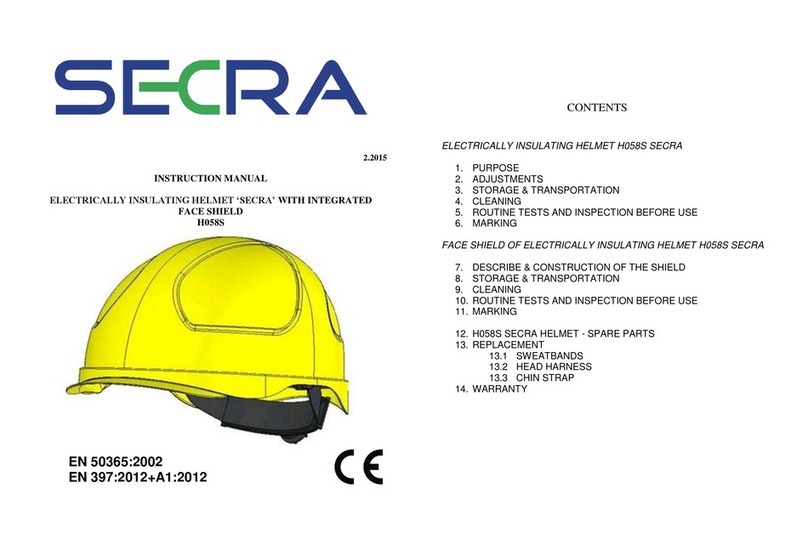
oznakowanie wytłoczone na tylnej, zewnętrznej części skorupy hełmu:
PROD X/XX data produkcji (kwartał / rok);
UTIL X/XX data utylizacji (kwartał / rok).
oznakowanie na tylnej, zewnętrznej części skorupy hełmu:
SECRA-1 typ hełmu.
oznakowanie na wizjerze:
1000V
symbol prac pod napięciem zgodnie z RFU nr 03-025/2012
2C-1,2 numer kodowy i stopień ochrony filtru UV;
HUBIX nazwa producenta;
1 klasa optyczna;
B odporność na uderzenia o średniej energii;
8-1-0 ochrona przed łukiem elektrycznym;
8 symbol ochrony zgodnie z EN 166:2001
-1 ochrona przed zagrożeniami termicznymi wywołanymi łukiem elektrycznym klasa 2
(4kA/0,5s) zgodnie z GS-ET 29:2010-02 “Supplementary requirements for the testing
and certification of face shields for electrical works”;
-0 współczynnik VLT >75% klasa 0, zgodnie z GS-ET 29:2010-02;
9 ochrona przed stopionymi metalami i gorącymi ciałami stałymi;
K odporność na uszkodzenia powierzchni przez drobne cząstki;
N odporność na zamglenie;
CE oznakowanie zgodności z Rozporządzeniem 2016/425.
oznakowanie wytłoczone na daszku:
HUBIX nazwa producenta;
EN 166:2001 norma odniesienia „Ochrona indywidualna oczu. Wymagania”;
3 ochrona przed kroplami i rozbryzgami cieczy;
8 ochrona przed łukiem elektrycznym;
9 ochrona przed stopionymi metalami i gorącymi ciałami stałymi;
B odporność na uderzenia o średniej energii.
3. REGULACJE
Przed użyciem hełm musi zostać odpowiednio wyregulowany tak aby zapewniał
skuteczną ochronę. Użytkownik powinien dopasować hełm do obwodu głowy, ustawić
wysokość noszenia i długość paska podbródkowego w taki sposób, aby hełm dobrze
pasował, nie przesuwał się i nie przechylał.
REGULACJA OBWODU GŁOWY
Hełm posiada regulację skokową obwodu głowy co 1mm w zakresie od 53cm do
63cm. Po nałożeniu hełmu na głowę należy dopasować go do obwodu głowy
obracając pokrętło regulatora (1) umieszczonego z tyłu hełmu (Fig.1). Obrót w lewo
(2) pozwala luzować a obrót w prawo (3) zaciskać opaskę regulatora.
REGULACJA WYSOKOŚCI NOSZENIA
Hełm posiada dwupozycyjną regulację wysokości noszenia (Fig.2). Po nałożeniu
hełmu na głowę należy upewnić się czy pasy nośne są odpowiednio ustawione do
wysokości głowy. Standardowo, zaczepy pasa (1) montowane są w pozycji płytkiej
(2). W celu zmiany wysokości noszenia, należy zamocować cztery zaczepy pasa w
pozycję głęboką (3).
REGULACJA PASKA PODBRÓDKOWEGO
Pasek podbródkowy (Fig.3) posiada regulację długości, indywidualnie dla lewej i
prawej części paska. Dla każdej z części można zmienić długość przedniego (1) i
tylnego (2) odcinka, przesuwając pasek przez rozdzielacz (3).
ZAPIĘCIE/ODPIĘCIE PASKA PODBRÓDKOWEGO
Aby zapiąć pasek należy wprowadzić w zatrzask (1) element paska (2) (Fig.4) Aby
odpiąć pasek należy odciągnąć zapinkę (1) i zwolnić element paska (2) z zatrzasku.
(Fig.5)
OPUSZCZANIE/PODNOSZENIE OSŁONY TWARZY
1. Aby opuścić (otworzyć) osłonę twarzy (Fig.6), należy delikatnie uchwycić ją za
daszek (1) i pociągnąć (2), aż całkowicie wysunie się na zewnątrz hełmu (3),
2. Aby podnieść (zamknąć) osłonę twarzy (Fig.7), należy najpierw delikatnie uchwycić
ją za daszek (1) a następnie wsunąć osłonę twarzy do hełmu, popychając ją do góry
(2).
UWAGA! Nieprawidłowe (niezgodne z instrukcją) użycie, otwieranie / zamykanie
osłony może spowodować jej uszkodzenie. Nie naciskaj zbyt mocno na części
osłony twarzy i nie zamykaj / nie otwieraj jej zbyt szybko.
4. KONTROLA PRZED UŻYCIEM
Przed każdym rozpoczęciem pracy należy dokonać oględzin hełmu i osłony twarzy.
Oględziny obejmują sprawdzenie:
obraku widocznych wad skorupy hełmu;
opoprawność działania regulacji obwodu głowy;
opoprawność zapięcia paska podbródkowego;
obraku widocznych wad osłony;
opoprawność działania osłony;
ookresu użytkowania.
W przypadku wykrycia mechanicznych (pęknięcia, głębokie rysy, itp.) lub
chemicznych (odbarwienia, wyblaknięcia, itp.) uszkodzeńskorupy, uszkodzeń
więźby, wadliwego działania regulacji obwodu głowy, wadliwego mocowania,
zapięcia lub uszkodzeń paska podbródkowego, a także mechanicznych (pęknięcia,
głębokie rysy, przedziurawienia), lub chemicznych (odbarwienia, zmatowienia itp.)
uszkodzeń osłony twarzy lub jej wadliwego działania oraz w przypadku powstania
wątpliwości co do zapewnienia optymalnego poziomu ochrony, hełm należy wycofać
z użytkowania.
Zwrócić uwagę na okres użytkowania hełmu, który wynosi 60 miesięcy od daty
produkcji oznaczonej na hełmie. Po tym okresie hełm wraz z osłoną należy wycofać
z użytkowania i poddać procesowi utylizacji.
Hełm zabrudzony nie może być użyty w pracach pod napięciem.
W przypadku zawilgocenia hełm należy dokładnie osuszyć przed użyciem.
UWAGA! Przed przystąpieniem do pracy, użytkownik powinien sprawdzić czy
ograniczenia elektryczne dla hełmów odpowiadają wartości znamionowej
napięcia i kategorii lub klasy zagrożeń, które mogą wystąpić podczas
użytkowania.




























